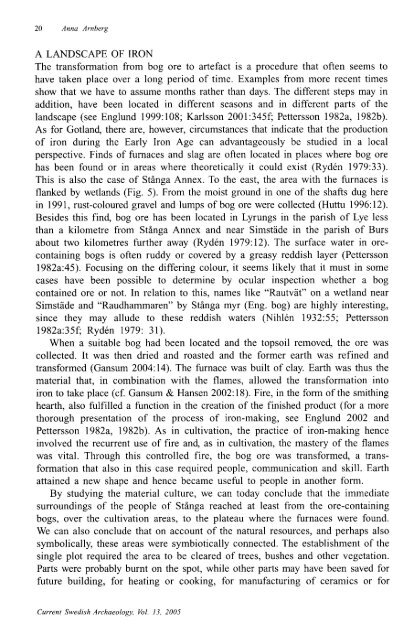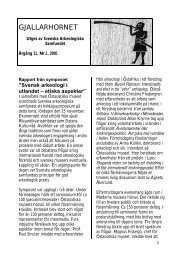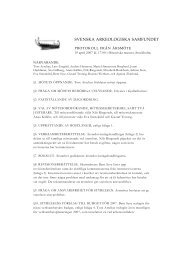Fields, Funerals and Furnaces Anna Arnberg - Svenska ...
Fields, Funerals and Furnaces Anna Arnberg - Svenska ...
Fields, Funerals and Furnaces Anna Arnberg - Svenska ...
You also want an ePaper? Increase the reach of your titles
YUMPU automatically turns print PDFs into web optimized ePapers that Google loves.
20 <strong>Anna</strong> <strong>Arnberg</strong><br />
A LANDSCAPE OF IRON<br />
The transformation from bog ore to artefact is a procedure that often seems to<br />
have taken place over a long period of time. Examples from more recent times<br />
show that we have to assume months rather than days. The different steps may in<br />
addition, have been located in different seasons <strong>and</strong> in different parts of the<br />
l<strong>and</strong>scape (see Englund 1999:108;Karlsson 2001:345f; Pettersson 1982a, 1982b).<br />
As for Gotl<strong>and</strong>, there are, however, circumstances that indicate that the production<br />
of iron during the Early Iron Age can advantageously be studied in a local<br />
perspective. Finds of furnaces <strong>and</strong> slag are often located in places where bog ore<br />
has been found or in areas where theoretically it could exist (Rydén 1979:33).<br />
This is also the case of Stånga Annex. To the east, the area with the furnaces is<br />
flanked by wetl<strong>and</strong>s (Fig. 5). From the moist ground in one of the shafts dug here<br />
in 1991, rust-coloured gravel <strong>and</strong> lumps of bog ore were collected (Huttu 1996:12).<br />
Besides this find, bog ore has been located in Lyrungs in the parish of Lye less<br />
than a kilometre from Stånga Annex <strong>and</strong> near Simstäde in the parish of Burs<br />
about two kilometres further away (Rydén 1979:12).The surface water in orecontaining<br />
bogs is often ruddy or covered by a greasy reddish layer (Pettersson<br />
1982a:45). Focusing on the differing colour, it seems likely that it must in some<br />
cases have been possible to determine by ocular inspection whether a bog<br />
contained ore or not. In relation to this, names like "Rautvät" on a wetl<strong>and</strong> near<br />
Simstäde <strong>and</strong> "Raudhammaren" by Stånga myr (Eng. bog) are highly interesting,<br />
since they may allude to these reddish waters (Nihlén 1932:55; Pettersson<br />
1982a:35f; Rydén 1979: 31).<br />
When a suitable bog had been located <strong>and</strong> the topsoil removed, the ore was<br />
collected. It was then dried <strong>and</strong> roasted <strong>and</strong> the former earth was refined <strong>and</strong><br />
transformed (Gansum 2004:14). The furnace was built of clay. Earth was thus the<br />
material that, in combination with the flames, allowed the transformation into<br />
iron to take place (cf. Gansum & Hansen 2002:18).Fire, in the form of the smithing<br />
hearth, also fulfilled a function in the creation of the finished product (for a more<br />
thorough presentation of the process of iron-making, see Englund 2002 <strong>and</strong><br />
Pettersson 1982a, 1982b). As in cultivation, the practice of iron-making hence<br />
involved the recurrent use of fire <strong>and</strong>, as in cultivation, the mastery of the flames<br />
was vital. Through this controlled fire, the bog ore was transformed, a transformation<br />
that also in this case required people, communication <strong>and</strong> skill. Earth<br />
attained a new shape <strong>and</strong> hence became useful to people in another form.<br />
By studying the material culture, we can today conclude that the immediate<br />
surroundings of the people of Stånga reached at least from the ore-containing<br />
bogs, over the cultivation areas, to the plateau where the furnaces were found.<br />
We can also conclude that on account of the natural resources, <strong>and</strong> perhaps also<br />
symbolically, these areas were symbiotically connected. The establishment of the<br />
single plot required the area to be cleared of trees, bushes <strong>and</strong> other vegetation.<br />
Parts were probably burnt on the spot, while other parts may have been saved for<br />
future building, for heating or cooking, for manufacturing of ceramics or for<br />
Current Swedish Archaeology, Vol. 13, 2005






